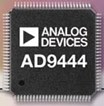Analog Devices Delivers 14-Bit ADC With High Spurious-Free Dynamic Range

 Norwood, MA -- Analog Devices today introduced a 14-bit, 80-MSPS (mega-samples-per-second) analog-to-digital converter (ADC) that offers high spurious-free dynamic range (SFDR). With wireless communications providers now carrying multiple radio standards, SFDR has become increasingly important for increasing call capacity and reducing dropped calls. The first in a family of high-speed, high-resolution ADCs optimized to improve the robustness and simplify the design of advanced 3G and next-generation 4G wireless base stations, the AD9444 provides a typical SNR of 73.1 dB and SFDR of 97 dBc with a 70 MHz input, a full 7 dB better than any other ADC in its class. Optimized for wireless base station applications, its high SFDR also makes the AD9444 well-suited to test equipment, wireless broadband, and high-end data acquisition systems.
Norwood, MA -- Analog Devices today introduced a 14-bit, 80-MSPS (mega-samples-per-second) analog-to-digital converter (ADC) that offers high spurious-free dynamic range (SFDR). With wireless communications providers now carrying multiple radio standards, SFDR has become increasingly important for increasing call capacity and reducing dropped calls. The first in a family of high-speed, high-resolution ADCs optimized to improve the robustness and simplify the design of advanced 3G and next-generation 4G wireless base stations, the AD9444 provides a typical SNR of 73.1 dB and SFDR of 97 dBc with a 70 MHz input, a full 7 dB better than any other ADC in its class. Optimized for wireless base station applications, its high SFDR also makes the AD9444 well-suited to test equipment, wireless broadband, and high-end data acquisition systems.
"The implementation of multi-carrier radio architectures in 3G has magnified the importance of SFDR to wireless systems designers," said Kevin Kattmann, product line director of the High-Speed Converter Group at Analog Devices. "To increase the capacity within a cell site and improve the quality of service per base station cell, 3G multi-carrier wireless designers require the high-performance receiver technology the AD9444 enables."
SFDR is a key specification used to qualify the performance of an ADC. A converter with a high SFDR can capture weak signals in the frequency band of interest, despite the presence of stronger signals. The 97 dBc SFDR of the AD9444 ADC expands the dynamic range of wireless base station receivers, while improving quality of service and lowering cost.
In addition to delivering 97 dBc SFDR and 73.1 dB SNR with a 70 MHz input, the AD9444 provides high accuracy, with typical differential nonlinearity (DNL) of +/-0.4 LSB, integral nonlinearity (INL) of +/-0.6 LSB, and power dissipation of 1.2 W. The ADC also features parallel low-voltage differential signaling (LVDS) outputs, including an output clock, simplifying the interface to digital down-converters and reducing the potential for digital noise coupling back into the ADC core. The AD9444 is the first device in a family of Analog Devices' high-speed ADCs that will offer higher sample rates, ease of use, and improved dynamic performance at competitive prices.
The LVDS output of the AD9444 interfaces seamlessly with the LVDS support of the AD6636 multi-channel wideband digital down converter, which is optimized for Analog Devices' TigerSHARC digital signal processor. Additionally, a clean clock source for the AD9444 is obtained when the device is used with the AD9510 high-performance clock distribution integrated circuit. The AD9444 is an ideal companion to Analog Devices' industry-leading TxDAC+ portfolio of digital-to-analog converters and VersaCOMM digital down and up converters. Together, these devices form the basis for a high-performance digital radio transceiver.
The AD9444 ADC is shipping in production volume now, available in Pb-free 100-lead TQFP_EP (Thin Quad Flat Pack Exposed Paddle). The device is supported by two evaluation boards and a behavioral model that can be used with Analog Devices' ADIsimADC modeling software.
Source: Analog Devices
